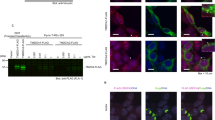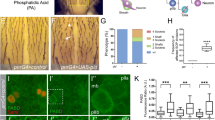Abstract
Notch receptors function in highly conserved intercellular signalling pathways that direct cell-fate decisions, proliferation and apoptosis in metazoans. Fringe proteins can positively and negatively modulate the ability of Notch ligands to activate the Notch receptor. Here we establish the biochemical mechanism of Fringe action. Drosophila and mammalian Fringe proteins possess a fucose-specific β1,3 N-acetylglucosaminyltransferase activity that initiates elongation of O-linked fucose residues attached to epidermal growth factor-like sequence repeats of Notch. We obtained biological evidence that Fringe-dependent elongation of O-linked fucose on Notch modulates Notch signalling by using co-culture assays in mammalian cells and by expression of an enzymatically inactive Fringe mutant in Drosophila . The post-translational modification of Notch by Fringe represents a striking example of modulation of a signalling event by differential receptor glycosylation and identifies a mechanism that is likely to be relevant to other signalling pathways.
This is a preview of subscription content, access via your institution
Access options
Subscribe to this journal
Receive 51 print issues and online access
$199.00 per year
only $3.90 per issue
Buy this article
- Purchase on Springer Link
- Instant access to full article PDF
Prices may be subject to local taxes which are calculated during checkout






Similar content being viewed by others
References
Artavanis-Tsakonas, S., Rand, M. D. & Lake, R. J. Notch signalling: Cell fate control and signal integration in development. Science 284, 770– 776 (1999).
Joutel, A. & Tournier-Lasserve, E. Notch signalling pathway and human diseases. Semin. Cell Dev. Biol. 9, 619–625 (1998).
Panin, V. M. & Irvine, K. D. Modulators of Notch signalling. Semin. Cell Dev. Biol. 9, 609– 617 (1998).
Panin, V. M., Papayannopoulos, V., Wilson, R. & Irvine, K. D. Fringe modulates notch ligand interactions. Nature 387, 908–912 (1997).
Fleming, R. J., Gu, Y. & Hukriede, N. A. Serrate-mediated activation of Notch is specifically blocked by the product of the gene fringe in the dorsal compartment of the Drosophila wing imaginal disc. Development 124, 2973–2981 ( 1997).
Klein, T. & Arias, A. M. Interactions among Delta, Serrate and Fringe modulate Notch activity during Drosophila wing development. Development 125, 2951– 2962 (1998).
Irvine, K. D. & Wieschaus, E. fringe, a boundary-specific signalling molecule, mediates interactions between dorsal and ventral cells during Drosophila wing development. Cell 79, 595–606 (1994).
Irvine, K. D. Fringe, Notch, and making developmental boundaries. Curr. Opin. Genet. Dev. 9, 434–441 ( 1999).
Irvine, K. D. & Vogt, T. F. Dorsal–ventral signalling in limb development. Curr. Opin. Cell Biol. 9, 867–876 (1997).
Johnston, S. H. et al. A family of mammalian Fringe genes implicated in boundary determination and the Notch pathway. Development 124 , 2245–2254 (1997).
Cohen, B. et al. Fringe boundaries coincide with Notch-dependent patterning centres in mammals and alter Notch-dependent development in Drosophila. Nature Genet. 16, 283–288 (1997).
Yuan, Y. P., Schultz, J., Mlodzik, M. & Bork, P. Secreted fringe-like signaling molecules may be glycosyltransferases. Cell 88, 9–11 (1997).
Moloney, D. J. et al. Mammalian Notch1 is modified with two unusual forms of O-linked glycosylation found on Epidermal Growth Factor-like modules. J. Biol. Chem. 275, 9604– 9611 (2000).
Harris, R. J. & Spellman, M. W. O-linked fucose and other post-translational modifications unique to EGF modules. Glycobiology 3, 219–224 ( 1993).
Moloney, D. J., Lin, A. I. & Haltiwanger, R. S. The O-linked fucose glycosylation pathway: evidence for protein specific elongation of O-linked fucose in Chinese hamster ovary cells. J. Biol. Chem. 272, 19046–19050 (1997).
Stanley, P., Narasimhan, S., Siminovitch, L. & Schachter, H. Chinese hamster ovary cells selected for resistance to the cytotoxicity of phytohemagglutinin are deficient in a UDP-N-acetylglucosamine-glycoprotein N-acetylglucosaminyltransferase activity. Proc. Natl Acad. Sci. USA 72, 3323–3327 ( 1975).
Robertson, M. A., Etchison, J. R., Robertson, J. S., Summers, D. F. & Stanley, P. Specific changes in the oligosaccharide moieties of VSV grown in different lectin-resistant CHO cells. Cell 13, 515–526 ( 1978).
Moloney, D. J. & Haltiwanger, R. S. The O-linked fucose glycosylation pathway: Identification and characterization of a UDP-glucose: O-fucose β1,3-glucosyltransferase. Glycobiology 9, 679–687 (1999).
Kao, Y. -H. et al. The effect of O-fucosylation on the first EGF-like domain from human blood coagulation Factor VII. Biochemistry 38, 7097—7110 (1999).
Beyer, T. A., Sadler, J. E., Rearick, J. I., Paulson, J. C. & Hill, R. L. Glycosyltransferases and their use in assessing oligosaccharide structure and structure-function relationships. Adv. Enzymol. 52, 23–175 (1981).
Lindsell, C. E., Shawber, C. J., Boulter, J. & Weinmaster, G. Jagged: A mammalian ligand that activates Notch1. Cell 80, 909–917 (1995).
Hicks, C., Johnston, S. H., DiSibio, G., Collazo, A., Vogt, T. F. & Weinmaster, G. Fringe differentially modulates Jagged1 and Delta1 signalling through Notch1 and Notch2 receptors in mammalian cells. Nature Cell Biol. (in the press).
Hsieh, J. J., Henkel, T., Salmon, P., Robey, E., Peterson, M. G. & Hayward, S. D. Truncated mammalian Notch1 activates CBF1/RBPJk-repressed genes by a mechanism resembling that of Epstein–Barr virus EBNA2. Mol. Cell. Biol. 16, 952–959 ( 1996).
Ripka, J. & Stanley, P. Lectin-resistant CHO cells: Selection of four new pea lectin-resistant phenotypes. Som. Cell Mol. Gen. 12, 51–62 ( 1986).
Ripka, J., Adamany, A. & Stanley, P. Two Chinese hamster ovary glycosylation mutants affected in the conversion of GDP-mannose to GDP-fucose. Arch. Biochem. Biophys. 249, 533–545 ( 1986).
Sullivan, F. X. et al. Molecular cloning of human GDP-mannose 4,6-dehydratase and reconsititution of GDP-fucose biosynthesis in vitro. J. Biol. Chem. 273, 8193–8202 ( 1998).
Ohyama, C. et al. Molecular cloning and expression of GDP-D-mannose-4,6-dehydratase, a key enzyme for fucose metabolism defective in Lec13 cells. J. Biol. Chem. 273, 14582–14587 (1998).
Wiggins, C. A. R. & Munro, S. Activity of the yeast MNN1 α-1,3-mannosyltransferase requires a motif conserved in many other families of glycosyltransferases. Proc. Natl Acad. Sci. USA 95, 7945–7950 ( 1998).
Zhang, Y., Malinovskii, V. A., Fiedler, T. J. & Brew, K. Role of a conserved acidic cluster in bovine β1,4 galactosyltransferase-1 probed by mutagenesis of a bacterially expressed recombinant enzyme. Glycobiology 9, 815–822 (1999).
Kim, J., Irvine, K. D. & Carroll, S. B. Cell recognition, signal induction, and symmetrical gene activation at the dorsal–ventral boundary of the developing Drosophila wing. Cell 82, 795– 802 (1995).
Brand, A. H. & Perrimon, N. Targeted gene expression as a means of altering cell fates and generating dominant phenotypes. Development 118, 401–415 ( 1993).
Ju, B. -G. et al. Fringe forms a complex with Notch. Nature 405, 191–195 (2000).
Rebay, I. et al. Specific EGF repeats of Notch mediate interactions with Delta and Serrate: Implications for Notch as a multifunctional receptor. Cell 67, 687–699 ( 1991).
Klueg, K. M. & Muskavitch, M. A. Ligand–receptor interactions and trans-endocytosis of Delta, Serrate and Notch: members of the Notch signaling pathway in Drosophila. J. Cell Sci. 112, 3289–3297 (1999).
Kelley, M. R., Kidd, S., Deutsch, W. A. & Young, M. W. Mutations altering the structure of Epidermal Growth Factor-like coding sequences of the Drosophila notch locus. Cell 51, 539–548 (1987).
De Celis, J. F. & García-Bellido, A. Roles of the Notch gene in Drosophila wing morphogenesis. Mech. Dev. 46, 109–122 ( 1994).
De Celis, J. F. & Bray, S. J. The Abruptex domain of Notch regulates negative interactions between Notch, its ligands and Fringe. Development 127, 1291– 1302 (2000).
Kornfeld, S. Diseases of abnormal protein glycosylation: An emerging area. J. Clin. Invest. 101, 1293–1295 (1998).
Lubke, T., Marquardt, T., von Figura, K. & Korner, C. A new type of carbohydrate-deficient glycoprotein syndrome due to a decreased import of GDP-fucose into the Golgi . J. Biol. Chem. 274, 25986–25989 (1999).
Perrimon, N. & Bernfield, M. Specificities of heparan sulphate proteoglycans in developmental processes. Nature 404 , 725–728 (2000).
MacArthur, C. A., Lawshe, A., Shankar, D. B., Heikinheimo, M. & Shackleford, G. M. FGF-8 isoforms differ in NIH3T3 cell transforming potential. Cell Growth Differ. 6, 817–825 (1995).
Lu, F. M. & Lux, S. E. Constitutively active human Notch1 binds to the transcription factor CBF1 and stimulates transcription through a promoter containing a CBF1-responsive element. Proc. Natl Acad. Sci. USA 93, 5663–5667 ( 1996).
Cheng, H. J., Nakamoto, M., Bergemann, A. D. & Flanagan, J. G. Complementary gradients in expression and binding of Elf-1 and Mek-4 in development of the topographic retinotectal projection map. Cell 82, 371–381 (1995).
Kotenko, S. V., Saccani, S., Izotova, L. S., Mirochnitchenko, O. V. & Pestka, S. Human cytomegalovirus harbors its own unique interleukin-10 homolog (cmvIL-10). Proc. Natl Acad. Sci. USA 97, 1695–1700 (2000).
Rebay, I., Fehon, R. G. & Artavanis-Tsakonas, S. Specific truncations of Drosophila Notch define dominant activated and dominant negative forms of the receptor. Cell 74, 319–329 (1993).
Hirschberg, C. B., Robbins, P. W. & Abeijon, C. Transporters of nucleotide sugars, ATP, and nucleotide sulfate in the endoplasmic reticulum and Golgi apparatus. Annu. Rev. Biochem. 67, 49–69 (1998).
Brou, C. et al. A novel proteolytic cleavage involved in Notch signalling: The role of the disintegrin-metalloprotease TACE. Mol. Cell 5, 207–216 (2000).
Mumm, J. S. et al. A ligand-induced extracellular cleavage regulates γ-secretase-like proteolytic activation of Notch1. Mol. Cell 5, 197–206 (2000).
De Strooper, B. et al. A presenilin-1-dependent γ-secretase-like protease mediates release of Notch intracellular fragment. Nature 398 , 518–522 (1999).
Acknowledgements
We thank K. Matta for disaccharide standards; K. Severinov for advice on protein purification; T. Correia, S. Narula and S. Sundaram for technical assistance; the Developmental Studies Hybridoma Bank; S. Lux and S. Kotenko for antibodies; G. Weinmaster for Jagged1-expressing mouse L cells and co-culture reagents; J. Flanagan for the AP-Tag plasmid; D. Hayward for CBF1-luciferase reporter plasmid JH26; J. Nye for the mouse Notch1 plasmid; S. Kotenko for Flag expression plasmid; and J. Botas and the Bloomington Stock Center for Drosophila stocks. We thank our colleagues for comments on the manuscript. S.H.J. was supported as a Harold W. Dodds Fellow of the Princeton University Graduate Program. Research in K.D.I.'s laboratory was supported by a GM NIH grant, and by Charles and Joanna Busch fellowships to V.P. and R.W. Research in R.S.H.'s laboratory was supported by a Grant Award from Neose Technologies, Inc. Research in P.S.'s laboratory was supported by a NIH/NCI grant and a NCI Comprehensive Cancer Center grant. Research in T.F.V's lab was supported by an NIH grant and a gift to the Department of Molecular Biology by the Rathmann Family Foundation.
Author information
Authors and Affiliations
Corresponding authors
Rights and permissions
About this article
Cite this article
Moloney, D., Panin, V., Johnston, S. et al. Fringe is a glycosyltransferase that modifies Notch. Nature 406, 369–375 (2000). https://doi.org/10.1038/35019000
Received:
Accepted:
Issue Date:
DOI: https://doi.org/10.1038/35019000
This article is cited by
-
Wnt, notch signaling and exercise: what are their functions?
Human Cell (2024)
-
A pan-cancer analysis revealing the role of LFNG, MFNG and RFNG in tumor prognosis and microenvironment
BMC Cancer (2023)
-
Identification of acquired Notch3 dependency in metastatic Head and Neck Cancer
Communications Biology (2023)
-
1H, 15N, 13C backbone and sidechain resonance assignments and secondary structure of mouse NOTCH1 EGF27
Biomolecular NMR Assignments (2023)
-
Notch signaling pathway: architecture, disease, and therapeutics
Signal Transduction and Targeted Therapy (2022)
Comments
By submitting a comment you agree to abide by our Terms and Community Guidelines. If you find something abusive or that does not comply with our terms or guidelines please flag it as inappropriate.



